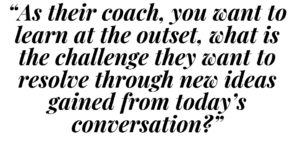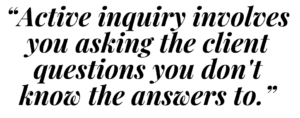
A coaching session starts with an important question that sets the stage for success: “What would you like to work on today?” or “What’s the outcome that you would like to achieve? or “What would make this the most valuable hour of your day?” By asking one of the variations of this question, you, as the coach, learn what they’d like to work on because it’s not your place to decide for them, they decide what they want to work on with you.
As their coach, you want to learn at the outset, what is the challenge they want to resolve through new ideas gained from today’s conversation?
After you’ve discovered what that outcome is, you then engage in “active inquiry.” Active inquiry involves you asking the client questions you don’t know the answers to. It’s really important that you don’t know the answers because you don’t want to lead, direct, or manipulate the conversation.

You want the client to discover the answers to their challenges within themselves, because that’s what coaching is. It’s not consulting and it’s not mentoring. Said another way, you are seeking to elicit the client’s ideas and help them gain new perspectives on their challenges by being solution oriented and thinking forward.
In the world of executive coaching, we spend very little time looking back. Instead, we look forward and work on new ideas, not worn-out ideas that have already been tried and failed in the past. We seek new ideas, new approaches, and new perspectives that can best be gained by asking the right questions at the right moments.
Open ended questions tend to work better in this regard because they open up the conversation and get your client talking. You absolutely want your client talking much more than you. You should be spending most of your time listening and observing.
When you pair active inquiry with active listening, where you’re fully present and totally taking in what the client’s saying, something really wonderful happens: the next question presents itself. You shouldn’t have to work too hard to determine what’s the next best question to ask your client. It should present itself when you ask good questions.
Think deeply about this and feel for it to occur in each and every coaching session. Combine active inquiry with active listening and just patiently wait for the next question to present itself. Don’t interrupt your client. Be careful to be patient, be quiet, and let them do the talking. They’ll tell you what to ask next.
After you’ve engaged in active inquiry, it’s time to ask for their insights. What have they discovered through this conversation that’s new to them? What realizations or insights do they now have?
And finally, you might ask about what action(s) will they take out of this coaching session? This is the accountability step, which is very important in some coaching engagements where the client is clearly looking for accountability as part of the process. This step entails you asking your clients to commit to an action and then holding them accountable to that action when you meet again.
Once you realize what action steps your client is likely to take, then you affirm them and generally close that coaching session and plan for the next coaching session. If you follow these steps:

- Ask about the outcome the client would like to achieve,
- Engage them in active inquiry with active listening,
- Talk about insights that they’ve gained
- Next actions they plan to take
You will have a solid process you can use again and again with clients to help them find success with you as their coach.
If you’d like to watch a video on becoming an executive coach, click here.
Continue reading on to part 3, and read part 1 if you haven’t yet!
If you’d like to talk with me 1 on 1 about your aspirations to be an executive and leadership coach, schedule time with me here or fill out the contact form.
Here are more articles and videos related to this article:
Articles
- Coaching Professionals Share 10 of Their Best Coaching Ideas
- Roles Coaches Play, Part One, Part Two, and Part Three
YouTube Videos
- Becoming an Executive Coach – Part 1, Part 2, and Part 3
- The One Question You Should Ask in Every Coaching Session | Executive Coaching Strategies
- A Key to Great Coaching Sessions – Ask These Types of Questions!
- Intro to Becoming an Executive Coach – Training Series by Michael Neuendorff
Photo copyright: Featured photo is from ©pressmaster via 123RF. Secondary photo is from ©fauxels via Pexels.







